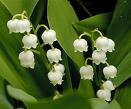
Lily of the valley is a rhizomatous herbaceous perennial native to the temperate parts of the Northern Hemisphere and grows best where summers are warm but not hot. Each plant has one to three basal leaves that are broadly lanceolate and about eight inches long. Five to fifteen nodding flowers are carried on one sided arching racemes in late spring. The bell-shaped flowers consist of five fused tepals, are usually white, sometimes pink, and are very fragrant. Orange-red berries with 1-6 seeds may follow in the fall. Also called Mary’s tears and mayflower, lily of the valley is native to the Northern Hemisphere of Europe and Asia and is a member of the asparagus family, Asparagaceae, that also includes yucca, hosta and snake plant. The genus name, Convallaria, comes from the Latin prefix con- and the Latin word vallis meaning valley. The specific epithet, majalis, honors Maia, the Roman goddess of fertility associated with the month May when lily of the valley blooms. All parts of this plant are very poisonous.
Lily of the Valley evokes many wonderful thoughts and feelings and many brides dream of having a bridal bouquet of them (very expensive even in season). I treasure the few that have managed to survive in my garden because of a dear friend and French teacher colleague of mine. who every May Day she gives a bouquet of Lily of the Valley to her fellow French teacher. Such a charming tradition. But wait, there is more…
May Day in France is a big deal to workers and somewhat like our Labor Day in September. May in France is very special because there are more official national holidays than in any other month so workers look forward to combining official national holiday with other holidays to create a really nice mini vacation. As May Day approaches, vendors come forth to sell Lily of the Valley (“porte-bonheur”–literally, “bringer of happiness) in bouquets or pots and the usual tax on plants/flower sales is laid aside. What a beautiful custom.
Type: Herbaceous perennial.
Bloom: White tinged with green, bell shaped very fragrant flowers borne in racemes in mid spring.
Size: 10-12”.
Light: Part to deep shade but tolerates some sun depending on water requirements.
Soil: Fertile, consistently moist, well-drained; will tolerate dryness once established.
Fertilizer: Organic mulch will provide nutrients for successful growth.
Hardiness: Zones 2-5 optimum, 7-8 ok, struggles in 8.
Care: Low maintenance
Pests: Leaf spot and stem rot. Remove and destroy the infected parts as soon as they’re noticed. It also helps to remove the dead foliage.
Propagation: Spreads quickly by rhizomes in moist, humus; the ends of the rhizomes produce new plants, called pips. These can be pricey to buy so shop around.
Companion plants: Other woodland species such as hostas, Tiarella, and ferns; good grown under trees, even black walnut, azaleas and rhododendrons.
Outstanding Selections:
‘Bordeaux’-larger flowers are borne profusely above the foliage rather than in it; foliage on red stems.
‘Fortin’s Giant-taller and with larger flowers than the species.
‘Plena’-cream colored flowers that are larger and more persistent than the species
‘Rosea’-Light pink flowers.
‘Striata’-Leaves with white stripes
Comments: Flowers highly esteemed for use in bridal bouquets. Excellent grounds cover if it likes the environment.

Very fitting to have lily of the valley on May Day. I love the scent!
Lily of the Valley are treasures and a great way to usher in the month of May. I sure wish there was a perfume or cologne that really replicated their scent.
Hi
Nice website. Wonder if you could help me out. My Lily of the Valley’s are
going under. They are turning black or purple
We had a tremendous amount of race since April
What should I do
I tried to attach a pic but it kept asking for a url. Do you have a regular
email address that I can attach the pic to?
Thanks
Mike
Mike
Sure, send me the picture and give me more details of the site, how long it has done will in that site, and your location in the country; kvmeyers@hotmail.com. In general, lily of the valley likes moisture but not standing in water, same shade, and humusy soil. It does well in zone 7 and colder but struggles in zone 8. Hope this helps.
Karen